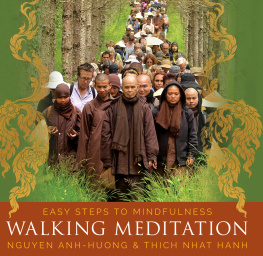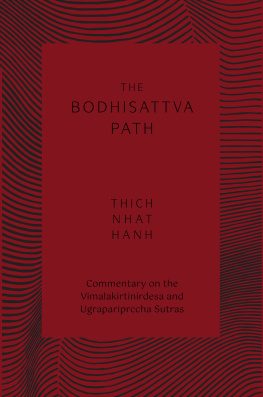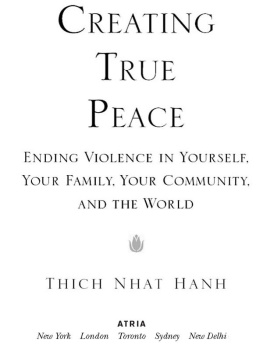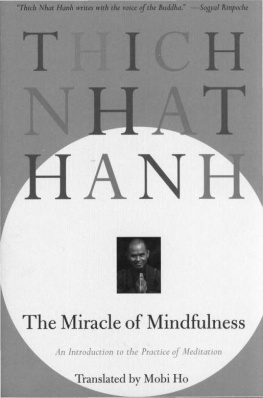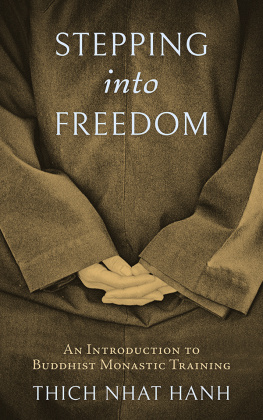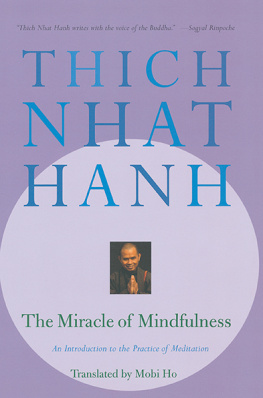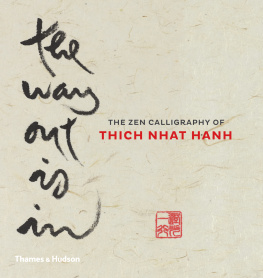


Walking Meditation
Take my hand.
We will walk.
We will only walk.
We will enjoy our walk
without thinking of arriving anywhere.
Walk peacefully.
Walk happily.
Our walk is a peace walk.
Our walk is a happiness walk.
Then we learn
that there is no peace walk;
that peace is the walk;
that there is no happiness walk;
that happiness is the walk.
We walk for ourselves.
We walk for everyone
always hand in hand.
Walk and touch peace every moment.
Walk and touch happiness every moment.
Each step brings a fresh breeze.
Each step makes a flower bloom under our feet.
Kiss the Earth with your feet.
Print on Earth your love and happiness.
Earth will be safe
when we feel in us enough safety.
THICH NHAT HANH

CONTENTS

INTRODUCTION
Peace Is Every Step
Peace is every step.
The shining red sun is my heart.
Each flower smiles with me.
How green, how fresh all that grows.
How cool the wind blows.
Peace is every step.
It turns the endless path to joy.
TINH THUY
senior student of Thich Nhat Hanh
I n the midst of our chaotic world, we tend to lose touch with the peace and joy that are available in each moment: the sunshine, the birds singing, the autumn leaves, a babys smile. The practice of walking meditation brings us back to being fully present and alive with every step, filling each moment with peace and joy.
Over the past four decades, my teacher, Zen Master Thich Nhat Hanh, has offered walking meditation practice to hundreds of thousands of people around the world. It has transformed many peoples lives, including my own. I was introduced to the practice in 1980, and it has stayed with me and become my life. I have shared it with many people at mindfulness workshops and retreats at the Mindfulness Practice Center of Fairfax in Oakton, Virginia, and elsewhere.
This book includes a complete program of meditation instruction that you can use to create your own walking meditation practice. Be sure to read the instructions for each practice before listening to the guided session. You will also be instructed when to watch the video, which features archival footage of the Venerable Thich Nhat Hanh instructing students in the basic practice of slow walking meditation. All five guided audio meditations and the instructional video are found on the Walking Meditation page of the Sounds True website at SoundsTrue.com/walkingmeditation/meditations.
It is with great happiness that I share the art of mindful walking with you. If you follow this training program wholeheartedly, the value of your practice will be beyond measure. The boundary between practice and non-practice will eventually disappear, and every time you take a step, it will be a peaceful one. Every time you walk, it will be a walking meditation.

CONSCIOUS BREATHING MEDITATION
The Welcoming Path
The empty path welcomes you,
fragrant with grass and little flowers,
the path paved with paddy fields
still bearing the marks of your childhood
and the fragrance of mothers hand.
Walk leisurely, peacefully.
Your feet touch the Earth deeply.
Dont let your thoughts carry you away,
come back to the path every moment.
The path is your dear friend.
She will transmit to you her solidity,
and her peace.
THICH NHAT HANH
M editation is not meant to help us avoid problems or run away from difficulties. It is meant to allow positive healing to take place. To meditate is to learn how to stopto stop being carried away by our regrets about the past, our anger or despair in the present, or our worries about the future. By practicing the art of stopping, we can enter the present moment and be nourished by the beauty and wonder of life in and around us: the smell of flowers, the warmth of sunshine, the color of the sky. To practice mindfulness is to begin to realize that we have a choiceto stop and rest or run, to be angry or happy. Once we choose to stop, everything will be okay.
Before learning walking meditation, we begin by learning how to breathe mindfully. This is the best way to help us learn to rest and stop. When we breathe and know that we are breathing, our wandering mind begins to rest on the pillow of our breath. A feeling of calm and ease then naturally arises.
The fundamental practice of conscious breathing meditation is to nourish your mindfulness and learn how to keep it present, alive, and strong. When you learn how to generate the energy of mindfulness and allow it to penetrate everything you do, understanding, compassion, and loving kindness will naturally flower in you. At the beginning you may think that you are practicing mindfulness only while walking, but then one morning you might make some tea; you pick up the mug and suddenly you can smell the tea more keenly than ever before. And as you take a sip, the tea becomes more delicious because the energy of mindfulness that you have developed allows you to taste it more directly and deeply.
Your breath is part of your body, so when your mind is in touch with your breath through mindful breathing, it is also in touch with your body. True rest and peace are the natural result of conscious breathing in which body, breath, and mind come into unity.
To practice basic conscious breathing meditation, sit comfortably and let your weight sink into the ground. You can also practice conscious breathing while standing, walking, or in any other position, or even while jogging. If you have physical limitations and cannot sit or stand comfortably, you can lie on your back. Whether you walk or jog, sit or stand, as long as you remain mindful of your breathing, peace and serenity are always with you.
Sit in such a way that you can enjoy each moment of your sitting. You can sit on a chair if sitting on a cushion is difficult for you. If you experience a lot of restlessness or resistance in your sitting, lie down instead.
Whether you are sitting or standing, keep your head and neck aligned with your spinal column by dropping your shoulders completely. If you are lying down, let your arms rest alongside your body at an angle that enables your shoulders to fully relax. Your hands can rest on your belly or on the floor. If you need to use a pillow, choose one that is thin enough to support your head without tensing your neck. To loosen your jaw, open your mouth as wide as you can three times, followed each time by a deep breath. Now, close your eyes and allow your facial muscles to relax completely by keeping a half-smile on your lips. A half-smile helps bring you back to the source of love, joy, and compassion within you. Let your breath flow naturally and allow the river of your breath to carry your gentle smile to every part of your body.
Next page
